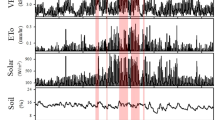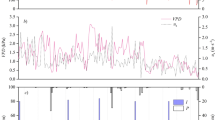Abstract
Global warming is affecting plant phenology, with potential consequences on the dynamics of growth reactivation of sugar maple and the timings of maple syrup production. In this study, we assess the temperatures inducing the daily reactivation or cessation of sap production. We selected 19 sugarbushes across Quebec, Canada, using a tapping method associated with the tubing system, we recorded the daily timings of onset and ending of sap production during winter and spring 2018, and we associated the hourly temperatures at each site. Sap production occurred from mid-February to the end of April, starting on average between 10 and 11 AM, and ending from 6 to 8 PM. We observed a seasonal pattern in the onset and ending of sap production during spring, with the onset showing a greater change than the ending. Onset and ending of sap production occurred mostly under temperatures ranging between –2 and 2 °C. The production of sap in maple is closely related to circadian freeze–thaw cycles and occurs under nighttime and daytime temperatures fluctuating below and above 0 °C. The daily lengthening of the duration of sap production mirrors the changes in the timings of freeze and thaw events and can be explained by the physical properties of the water and the physiological processes occurring during growth reactivation. The ongoing warming will result in earlier and warmer springs, which may anticipate the cycles of freeze and thaw and advance sap production in sugar maple.




Similar content being viewed by others
References
Boulanger Y, Pascual J, Bouchard M, D’Orangeville L, Périé C, Girardin MP (2021) Multi-model projections of tree species performance in Quebec, Canada under future climate change. Global Change Biol 28:1884–1902
Boulouf Lugo J, Deslauriers A, Rossi S (2012) Duration of xylogenesis in black spruce lengthened between 1950 and 2010. Ann Bot-London 110:1099–1108
Cirelli D, Jagels R, Tyree MT (2008) Toward an improved model of maple sap exudation: The location and role of osmotic barriers in sugar maple, butternut and white birch. Tree Physiol 28:1145–1155
Chagnon M, Paré D, Hébert C, Camiré C (2001) Effects of experimental liming on collembolan communities and soil microbial biomass in a southern Quebec sugar maple (Acer saccharum Marsh.) stand. Appl Soil Ecol 17:81–90
Delmez F, Vandenberghe V (2018) Long working hours make us less productive but also less costly. Labour 32:259–287
Duchesne L, Houle D (2014) Interannual and spatial variability of maple syrup yield as related to climatic factors. PeerJ 2:1–17
Duchesne L, Houle D, Côté MA, Logan T (2009) Modelling the effect of climate on maple syrup production in Québec, Canada. Forest Ecol Manag 258:2683–2689
Easterling DR, Karl TR, Gallo KP, Robinson DA, Trenberth KE, Dai A (2000) Observed climate variability and change of relevance to the biosphere. J Geophys Res 105:20101–20114
Graf G, Ceseri M, Stockie J (2015) Multiscale model of a freeze–thaw process for tree sap exudation. J R Soc Interface 12:1–15
Greene MT, Marvin JW (1958) The water content of maple stems. ii. Apparent changes in the water content of maple stems and the physiology of maple sap flow. Plant Physiol 33:173–176
Guo X, Khare S, Silvestro R, Huang J, Sylvain JD, Delagrange S, Rossi S (2020) Minimum spring temperatures at the provenance origin drive leaf phenology in sugar maple populations. Tree Physiol 40:1639–1647
Guo X, Klisz M, Puchałka R, Silvestro R, Faubert P, Belien E, Huang J, Rossi S (2020) Common-garden experiment reveals clinal trends of bud phenology in black spruce populations from a latitudinal gradient in the boreal forest. J Ecol 110:1043–1053
Heiligmann RB, Koelling MR, Perkins TD (2006) North American maple syrup producers manual. Ohio State University Extension, Ohio
Houle D, Paquette A, Côté B, Logan T, Power H, Charron I, Duchesne L (2015) Impacts of climate change on the timing of the production season of maple syrup in Eastern Canada. PLoS One 10:1–14
IPCC (2021) Climate change 2021: the physical science basis. In: Masson-Delmotte V, Zhai P, Pirani A, Connors SL, Péan C, Berger S, Caud N, Chen Y, Goldfarb L, Gomis MI, Huang M, Leitzell K, Lonnoy E, Matthews JBR, Maycock TK, Waterfield T, Yelekçi O, Yu R, Zhou B (eds) Contribution of working group I to the sixth assessment report of the intergovernmental panel on climate change. Cambridge University Press, In Press
Kim YT, Leech RH (1985) Effects of climatic conditions on sap flow in sugar maple. Forest Chron 61:303–307
MacIver D, Karsh M, Comer N, Klaassen J, Auld H, Fenech A (2006) Atmospheric influences on the sugar maple industry in North America. Envi Canada 7:1–22
Marvin JW, Erickson RO (1956) A statistical evaluation of some of the factors responsible for the flow of sap from the sugar maple. Plant Physiol 55:57–61
Matthews SN, Iverson LR (2017) Managing for delicious ecosystem service under climate change: can United States sugar maple (Acer saccharum) syrup production be maintained in a warming climate? Ecosys Serv Manag 13:40–52
Milburn JA, O’Malley PRER (1984) Freeze-induced sap absorption in Acer pseudoplatanus: a possible mechanism. Can J Botany 62:2101–2106
Muñoz-Sabater J, Lawrence H, Albergel C, Rosnay P, Isaksen L, Mecklenburg S, Kerr Y, Drusch M (2019) Assimilation of temperatures in the ECMWF integrated forecasting system. Quart J Roy Meteor Soc 145:2524–2548
Pallardy SG (2017) Physiology of woody plants. Academic Press, Columbia
Pencavel J (2014) The productivity of working hours. Econ J 125:2052–2076
Pires MA, Andrade RS, Iglesias M (2021) Effect of Temperature on Physical Properties of Canadian Maple (Acer saccharum marsh) Syrup. J Bioeng Tech Appl Health 4:30–36
Plamondon AP, Bernier PY (1980) Modélisation de la coulée de l`érable à sucre (Acer saccharum Marsh.) à partir d`éléments météorologiques. Can J Forest Res 10:152–157
Prislan P, Gričar J, Čufar K, de Luis M, Merela M, Rossi S (2019) Growing season and radial growth predicted for Fagus sylvatica under climate change. Clim Change 153:181–197
Rapp JM, Lutz DA, Huish RD, Dufour B, Ahmed S, Morelli TL, Stinson KA (2019) Finding the sweet spot: shifting optimal climate for maple syrup production in North America. Forest Ecol Manag 448:187–197
Ren P, Liang E, Raymond P, Rossi S (2020) Phenological differentiation in sugar maple populations and responses of bud break to an experimental warming. Forests 11:1–10
Rossi S, Morin H, Deslauriers A (2011) Multi-scale influence of snowmelt on xylogenesis of black spruce. Arct Antarct Alp Res 43:457–464
Schenk HJ, Jansen S, Hölttä T (2021) Positive pressure in xylem and its role in hydraulic function. New Phytol 230:27–45
Skinner CB, DeGaetano AT, Chabot BF (2010) Implications of twenty-first century climate change on Northeastern United States maple syrup production: Impacts and adaptations. Clim Change 100:685–702
Tyree MT (1983) Maple sap uptake, exudation, and pressure changes correlated with freezing exotherms and thawing endotherms. Plant Physiol 73:277–285
Tyree MT, Zimmermann MH (2002) Xylem structure and the ascent of sap. Springer, New York
Vincent LA, Zhang X, Brown RD, Feng Y, Mekis É, Milewska EJ, Wang XL (2015) Observed trends in Canada’s climate and influence of low-frequency variability modes. J Climate 28:4545–4560
Wang X, Guo J, Fenech A et al (2022) Future climate projections for Eastern Canada. Clim Dyn 1:1–16
Wegge P, Rolstad J (2017) Climate change and bird reproduction: warmer springs benefit breeding success in boreal forest grouse. P R Soc B 284:1–10
Wiegand KM (1906) Pressure and flow of sap in the maple. Am Nat 40:409–453
Yang B, He M, Shishov V, Tychkov I, Vaganov E, Rossi S, Ljungqvist FC, Bräuning A, Grießinger J (2017) New perspective on spring vegetation phenology and global climate change based on Tibetan Plateau tree-ring data. P Natl Acad Sci USA 114:6966–6971
Acknowledgements
The authors thank F. Gionest for technical support; L.C. Doria, D.S. Podadera, J. Gao, and A. Deslauriers for providing comments on the manuscript; and A. Garside for checking the English text.
Funding
This work was funded by the Natural Sciences and Engineering Research Council of Canada (research programs Alliance and Discovery grants), the Observatoire régional de recherche en forêt boréale, the Syndicat des producteurs des bois du Saguenay-Lac-Saint-Jean, the Producteurs et productrices acéricoles du Québec, the Centre ACER, and the Fondation de l’Université du Québec à Chicoutimi.
Author information
Authors and Affiliations
Corresponding author
Ethics declarations
Ethical standards
The experiments comply with the current laws of the country in which they were performed.
Competing interests
The authors declare no competing interests.
Rights and permissions
Springer Nature or its licensor (e.g. a society or other partner) holds exclusive rights to this article under a publishing agreement with the author(s) or other rightsholder(s); author self-archiving of the accepted manuscript version of this article is solely governed by the terms of such publishing agreement and applicable law.
About this article
Cite this article
Kurokawa, S.Y.S., Weiss, G., Lapointe, D. et al. Daily timings of sap production in sugar maple in Quebec, Canada. Int J Biometeorol 67, 211–218 (2023). https://doi.org/10.1007/s00484-022-02399-8
Received:
Revised:
Accepted:
Published:
Issue Date:
DOI: https://doi.org/10.1007/s00484-022-02399-8




